

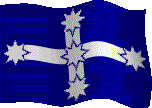
[ Takver's Initiatives ] [ Radical Tradition Contents ] [ Eureka Index ]
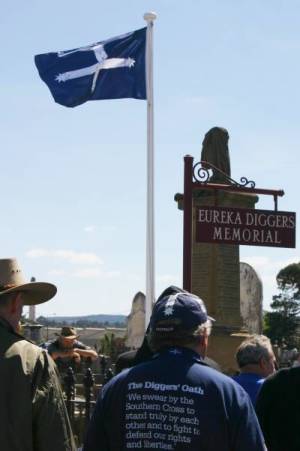 I'm afraid I'm all Eureka'd out. Three days of non stop remembrance. Up at
3am on Friday the 3rd December, verbal jostling with inebriated remnants of
the previous evenings concert that are warming themselves next to 44 gallon
drums, hastily erected on the Eureka monument.
I'm afraid I'm all Eureka'd out. Three days of non stop remembrance. Up at
3am on Friday the 3rd December, verbal jostling with inebriated remnants of
the previous evenings concert that are warming themselves next to 44 gallon
drums, hastily erected on the Eureka monument.
4am sanity, 100 hardy souls form a circle waiting for dawn to break behind the Reclaim the Radical Spirit of the Eureka rebellion banner on the spot the battle took place 150 years ago. The Southern Cross gives way to the light, the screams and groans of the injured provides a silent witness to the monument.
Hundreds gather beside the lake next to the Eureka Centre to gawk at a choreographed spectacle bankrolled by the State government. Massed choirs sing sugared thoughts. The Premier co-opts the celebrations by singing the praises of Clayton's democracy. The dead diggers, bystanders and soldiers are fortunately relieved of the need to see history rewritten by the State to suit the interests of the moment.
Direct Democracy Not Parliamentary Rule launched at the Eureka stockade site 150 years ago after the sons and daughters of Bakery Hill seized the moment and rewrote history. 9am, banners raised, black and blue and white flags raised, the long march begins. 100 excited souls reclaim the streets, walk 6 kilometres to the Old Ballarat cemetery to pay respects to workers who died at either end of a bayonet. We regroup and march to the Ballarat Hospital to pay our respects to Jeffrey Currie, a fellow militant in hospital, who patiently awaits the inevitable.
The group walks off, banners raised, seizes the initiative and marches down the main street of Ballarat to the blank stares and occasional show of support from those who have come to shop till they drop. Bakery Hill beckons, we swear the Eureka Oath repeating the words spoken by a 12 year old girl who has walked over 10 kilometres with us, 'We swear by the Southern Cross to stand truly by each other and fight to defend our rights and liberties'.
We walk back to Eureka Park 5 hours later and join the CFMEU picnic on the stockade site.
Saturday the Diggers march, Sunday 3.30am the Eureka Dawn Walk, the Eureka oration follows the walk. Lunch at the Old Colonist's Club in the heart of Ballarat from midday to 5pm, raw emotion baked dry in the oven of conformity and expectations, no wonder I'm all Eureka'd out!!
'The Battle of the Flags'
Men, women and children trekked to Ballarat to pay their respects to the dead, to mark the 150th anniversary of the Eureka rebellion. The Ballarat City Council with the help of the State government has put on a show, turning a sacred moment into blue and white entertainment. John Howard stays away, Federal Parliament House surrounded by a sea of Eureka flags, does not fly a Eureka flag from its massive flagpole.
The chattering classes tut-tut, the conservatives celebrate. The Queen's honour remains intact, no rebel flag flying above Parliament House in Canberra. The Ballarat City Council, a bastion of conservatism, secretly hails John Howard, no Eureka flags for them. While the world wails about the Prime Minister's insensitivity, the City Councillors escape public condemnations. No Eureka flag flies from the top of Ballarat City Council. The Councillors love the blue and white dollars the celebrations bring to the city, but no flag flies from the highest point on City Hall.
A smaller Eureka flag shares a spot with the Aboriginal flag on a vantage point on City Hall. No proud blue and white Eureka flag was flown from the top of City Hall in Ballarat, although it was the 150th celebration of a moment that continues to have enormous relevance to many people.
The Prime Minister is admonished for refusing to fly the flag. The Ballarat City Council escapes public censure for not flying the flag at the very top of Ballarat City Hall. If they want the city to luxuriate in the blue and white dollar, they'll have to do better than that in 2005. If no blue and white rebel flag flies over the top of Ballarat City Hall next year, the blue and white brigade will keep their blue and white dollars in their pockets.
People will come, mark the moment and keep their money in their pockets unless the Ballarat City Council does more than pay lip service to the Eureka spirit and flies the Eureka flag at the top of Ballarat City Hall to mark the 151st anniversary of the Eureka rebellion.
Those readers who made the pilgrimage to Ballarat for the 150th anniversary of the Eureka rebellion and participated in any of the activities that were held over those 3 days would have at sometime found themselves in Eureka Park, the likely site of the Eureka rebellion.
In one corner of the park is the beaut Eureka Centre built from seeding money given by the Federal and State government to the Ballarat City Council. This is a modern building built a few years ago run by the Ballarat City Council that promotes the idea that it provides a comprehensive view about Eureka.
On the other side of the park is an old fashioned hall that was built in the 1930's that is used by various groups as diverse as the Anarchist Media Institute, the Eureka Association, local dance groups, the CFMEU for their annual picnic at Eureka Park and locals celebrating milestones in their lives.
An interesting, old fashioned memorial that was built in 1884 nestles next to the hall. Made of bluestone, rectangular in shape, a few steps lead to a platform on which rises a monument where a marble slab that records some of the names of the miners killed as well as the names of the soldiers killed in the Eureka massacre was added sometime in the 1920's to the base of an old fashioned sandstone obelisk that was erected in 1884.
On top of that rectangular monument which is around 1.5 metres high, stand 4 old fashioned cannons set into freshly painted green timber mountings that stand on each corner of the monument. It seems the cannons were a gift of the British government to the Victorian government for their assistance in the Crimean War.
The Victorian State government, unsure of what to do with the 4 cannons that it suddenly found in its possession, passed them on to the Ballarat City Council. The Council, finding itself in possession of 4 Crimean cannons at the very moment the Eureka monument was being built, incorporated them in to the monument. When you first look at the monument, the placement of the 4 cannons tends to look as an after sight, as they are way too big for the monument.
The stockade site memorial is an open monument to many of those who died on the Eureka battlefield, as well as a silent and forgotten monument to those colonial soldiers from Victoria who participated in the Crimean War on behalf of mother England. What seems a very strange juxtaposition in 2004 is something that seems to have been readily accepted in 1884.
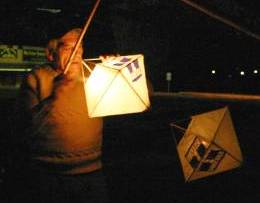 Andrew Bolt's extraordinary attack on the artistic director of the Eureka
Dawn Lantern Walk (Herald Sun 5/12) cannot go unchallenged. I first met Mr.
Graeme Dunstan when he contacted me last year to be the 'leading light' at
the Eureka Dawn Lantern Walk in 2003. The Ballarat City Council, through
the Bendigo Fine Arts Gallery, had been supporting the dawn walk since it
was started in 1997. In 2003, funding from the City Council was withdrawn
for a number of Eureka events including the Eureka Dawn Lantern Walk.
Andrew Bolt's extraordinary attack on the artistic director of the Eureka
Dawn Lantern Walk (Herald Sun 5/12) cannot go unchallenged. I first met Mr.
Graeme Dunstan when he contacted me last year to be the 'leading light' at
the Eureka Dawn Lantern Walk in 2003. The Ballarat City Council, through
the Bendigo Fine Arts Gallery, had been supporting the dawn walk since it
was started in 1997. In 2003, funding from the City Council was withdrawn
for a number of Eureka events including the Eureka Dawn Lantern Walk.
Mr. Dunstan used his own meagre resources to ensure that the 2003 Eureka Dawn Lantern Walk went ahead. He was paid $2500 for his role in this year's extremely successful Eureka Dawn Lantern Walk. He spent over 300 hours, spread over a month, to make all the necessary preparations that are required to make the walk such a success. This means he was paid the princely sum of $8.00 an hour for his efforts. I don't believe many people would do the work he has done over the past 7 years for such a paltry sum.
Mr. Dunstan has not received any other arts grant money in the past 20 years as stated by Mr. Bolt. He has no property, lives in a van and for the past 40 years has provided his services as a lantern maker to many community festivals around Australia free of charge. Before denigrating Mr. Dunstan from his column, Mr. Bolt would have been wise to check his facts. His claims that Mr. Dunstan feeds off art grants are wrong. Mr. Dunstan finished 3 years of a 4 year course at the Royal Military College at Duntroon in the early 1960's. He was so upset by his experiences that he has spent the last 40 years promoting peace as an alternative to war.
Graeme Dunstan is one of those unknown Australian legends who, through a lifetime of work, have made a positive impact on this country. In my opinion, his attempts to bring people together through his artistic endeavours over a lifetime, far outweighs any community contributions Andrew Bolt may have made through his superficial and divisive column in the Herald Sun.
After participating for the last two years in commemorative events for the Eureka Rebellion, it seemed natural that I would attend the 150th anniversary commemoration. One of my fears was that the event would be watered down to an occasion for generating tourist dollars around Ballarat. Equally, I was afraid the history of the event would be watered down and over simplified. Both of these happened to some extent, but perhaps not to the extent of my worst fears.
Accommodation in Ballarat seemed to be booked out, although there was always room for camping. Some trade unionists did so in Eureka Park, which was a fitting reminder of how diggers lived 150 years ago. Restaurants also seemed pretty full around town.
An enterprising entrepreneur had set up a fast food van in Eureka Park. They had a constant stream of customers all weekend.
The events I attended did not, in the main, over simplify the history. But the reporting I saw on television, radio or in print still suffered from simplifying the history to remembrance of a rebellion against unjust mining licences.
Perhaps the major concern was the attempt by politicians and others to depoliticise the event. To rip the heart out of Eureka. The Eureka Stockade was a political event, and remains so today, much to the chagrin of many conservatives.
The union movement were prominent over the weekend in proclaiming the Eureka rebellion as part of their heritage. And there are strong grounds for this claim. Craft unionism was still in an early formative period in the 1850s. Some of the diggers were chartists like JB Humffray or George Black. Others like Raffaello Carboni were radicals and revolutionists from the revolutions of 1848 in Europe. The Irish diggers had direct experience of British colonial despotism. Many of the diggers would become union members and organisers in later years, like Monty Miller.
Probably due to a shortage of labour caused by the gold rush, stonemasons achieved an 8 hour day in Melbourne in 1856. A world first. The Operative Stonemasons’ Society was founded in Melbourne in 1850.
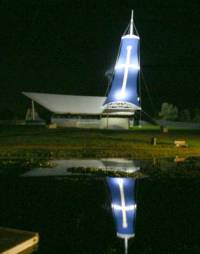 At the Eureka Memorial. Organised by the Electrical Trades Union (ETU). Songs, stories and performances 'celebrating 150 years of freedom and a fair go.'
At the Eureka Memorial. Organised by the Electrical Trades Union (ETU). Songs, stories and performances 'celebrating 150 years of freedom and a fair go.'
My family and friends drove up from Melbourne. We stayed at the Eureka Stockade Caravan Park, which is close to Eureka Park, right next to the swimming pool. After our meal, we put the children to bed and some of us wandered over to the memorial where the Trade Union organised concert was in progress. Shane Howard performed 'Solid Rock' and several other songs. People warmed themselves beside two fires in drums on the memorial.
Thursday night: A wander down to the pond revealed a reflection in the dark water of the lighted Eureka sail over the Eureka Stockade Centre. Turning around and facing south and you can see the Southern Cross and the two pointers in the night sky.
A pre dawn commemoration at the Eureka Memorial marked the anniversary of the attack on the Stockade. Fifty or sixty people gathered around in a circle. Graeme Dunstan, organiser of the Eureka dawn walk, arrived to setup his banners and lanterns. After a short introduction by Joe Toscano, of the Anarchist Media Institute, we took turns in talking on the meaning of the Eureka rebellion and its relevance today. A powerful, direct and moving experience. Everyone was given an opportunity to express their feelings. All viewpoints were listened to.
After dawn, the 'Reclaim the Radical Spirit of Eureka' banner became a popular spot to be photographed beside. Many people also stopped to read the honour roll of the thirteen men found not guilty of high treason.
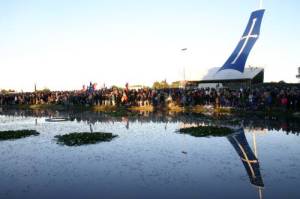 The official dawn commemoration ceremony was held at the pond in Eureka Park. The story of Eureka was narrated by iconic Australian actor, John Flaus. It also featured a welsh choir, a naval brass band, didgeridoo and clap sticks.
The official dawn commemoration ceremony was held at the pond in Eureka Park. The story of Eureka was narrated by iconic Australian actor, John Flaus. It also featured a welsh choir, a naval brass band, didgeridoo and clap sticks.
I heard criticism that the official ceremony did not pay sufficient respect to the original indigenous inhabitants and having two 'aborigines' dressed in possum skins on a pontoon in the middle of the pond seemed pretty tacky. Five fires burned in the lake, and as sunrise ocurred the fires one by one were extinguished, to the sound of the Welsh choir and a solo singer and the Naval brass band dressed in naval whites.
The television news got their 30 seconds of visuals, radio stations got their sound grabs and the audience got their theatrical spectacular. The best special effects were provided by nature: the crowd watched the colours of the dawn sky, the light change on the people and the Eureka Stockade Centre with its enormous Eureka flag banner.
More than 2,000 people attended, many with Eureka flags. Students from Heidelberg primary school were present. Many union banners, in particular the CFMEU and ETU flags waved in the slight breeze, as the sun slowly rose striking the Eureka sail on the Eureka Stockade Centre.
Union members trickled back to the Memorial Hall for breakfast. Unionits from Eureka Tiles across the road walked out of their factory to join their fellow unionists in Eureka Park. There was disgust that the Bracks Labor Government chose not to make the day a state public holiday for the 150th anniversary.
People marched under the 'Reclaim the Radical Spirit of the Eureka Rebellion' banner to the old cemetery to pay respects and visit the Diggers memorial and the Soldiers memorial.
The cemetery provided another opportunity for people to speak about what Eureka meant to them. The diggers memorial was erected on the 22nd March 1856. The column bearing the names clearly states that the men who are buried in this common pit were killed as a result of 'resisting the unconstitutional proceedings of the Victorian Government'.
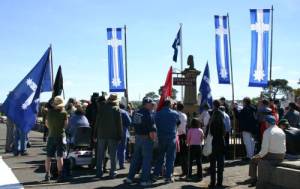 Some thirty diggers are known to have lost their lives, although it is thought that many severely wounded were carried away and later died, but their numbers are not known. Prof John Molony estimates that perhaps fifty diggers and five police died as a result of the attack on the Eureka Stockade.
Some thirty diggers are known to have lost their lives, although it is thought that many severely wounded were carried away and later died, but their numbers are not known. Prof John Molony estimates that perhaps fifty diggers and five police died as a result of the attack on the Eureka Stockade.
At the soldiers monument 50 metres away a tree grows next to a substantial marble monument that was built by the Government of Victoria, we are told in 1879, at the request of the citizens of Ballarat. The inscription on the monument states that the soldiers died "whilst attacking a band of aggrieved diggers in arms against what they regarded as a tyrannous administration." A further inscription below the first implies that the miners had died for nothing, as the demands they fought for, were granted constitutionally by the Victorian Government not long after the revolt.
Two versions of the same event, with the later version supplied by the Victorian Government. There is a struggle going on for writing the history of the event just 25 years after it occurred.
The battle fought between the troopers and stockaders was reputed to be over within fifteen minutes. The newly formed (1853) Victorian Police then proceeded to butcher anyone they found including the wounded, the dying, even innocent bystanders, for up to an hour in the stockade and surrounding area. This is why there have been recent calls for the Victorian Police Commissioner, Christine Nixon, to apologise to the people of Victoria for such barbarity and butchery by the Victorian Police.
Leaving the soldiers memorial I stopped for a moment at the monument to James Scobie, whose death, and the subsequent acquital of Hotel owner Bentley, contributed to the agitation at Ballarat.
The march then continued to Ballarat Base Hospital where a delegation visited a union organiser inside. After a long wait the march continued down the main street of Ballarat to Bakery Hill.
BLF Green Ban saved Bakery Hill
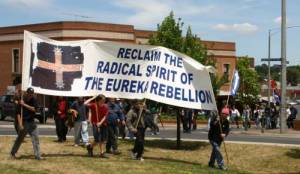 One of the interesting historical facts mentioned on the march, is that the Builders Labourers Federation put a green ban on this site to stop the development of a McDonalds restaurant directly on the site. McDonalds subsequently developed close by, but it is by the actions of builders labourers and their union that the historical site of Bakery Hill, the gathering and meeting place of the Eureka miners, is preserved for future generations. One day the BLF will have a small plaque commemorating their roll in safeguarding the history of Eureka.
One of the interesting historical facts mentioned on the march, is that the Builders Labourers Federation put a green ban on this site to stop the development of a McDonalds restaurant directly on the site. McDonalds subsequently developed close by, but it is by the actions of builders labourers and their union that the historical site of Bakery Hill, the gathering and meeting place of the Eureka miners, is preserved for future generations. One day the BLF will have a small plaque commemorating their roll in safeguarding the history of Eureka.
At Bakery Hill a decision was taken for 2005 to march to Bakery Hill and the cemetery. The oath was then affirmed by all present. The march then proceeded back to Eureka Park and joined a picnic/barbecue organised by the Construction Forestry Mining Energy Union (CFMEU).
See Also:
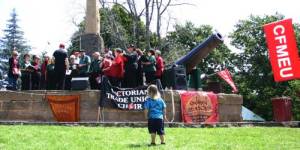 In a long tradition of union picnic days, the CFMEU had provided a jumping castle, train rides, and a farmyard petting zoo for the entertainment of children. Musical entertainment included Shane Howard and Trade Union choirs.
In a long tradition of union picnic days, the CFMEU had provided a jumping castle, train rides, and a farmyard petting zoo for the entertainment of children. Musical entertainment included Shane Howard and Trade Union choirs.
In many ways the union commemoration brought to mind the coming together of Unions and Friendly Societies that ocurred frequently at the end of the Nineteenth and early Twentieth centuries. These events were characterised by marches and parades followed by athletics carnivals and festivals to entertain families and children of members. These events provided the social glue that built solidarity and unity. Such social events are all too infrequent in our atomised society.
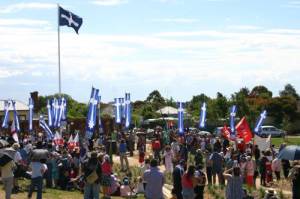 From Bakery Hill to the Eureka Stockade site the march traced the route the diggers took 150 years ago on November 30 1854.
From Bakery Hill to the Eureka Stockade site the march traced the route the diggers took 150 years ago on November 30 1854.
After the crowds gathered on Bakery Hill a warm welcome was extended to the crowd, which included representatives from some of the countries whose citizens took part in the Stockade. The speaker then said that questions had been raised about the presence of many trade unionists carrying union banners. Unions had originally excluded many people, women, aboriginies and Chinese, said the speaker, but over the years the unions had become more inclusive, we should follow their example. Eureka, he said, belongs to all Australians. One group however was not mentioned at the start of the march. There was no speaker from the aboriginal community and no acknowlegement or respect paid.
Next Peter Lalor, a descendent of the miners leader at the Eureka Stockade in 1854, led the crowd in affirming the Eureka oath.
Professor John Molony provided a narration on the story of the Diggers March at a number of points of interest. When the march reached the Eureka site, details were given of the women's sewing circle who put together the Southern Cross flag, and the more recent sewing circle that prepared many of the banners for commemorating the event.
The march ended with lunch and entertainment around the Eureka memorial.
Professor John Molony ended his narration with information and history of the Memorial and the importance of Eureka for Australian republicanism.
|
|
A reflective and meditative walk with hundreds of purpose built candle lanterns. It traced the route of the soldiers on their march from the Government Camp in Ballarat, along the river, to their assault on the Eureka Stockade that fateful Sunday morning 150 years ago. Over a thousand people took part in this event, now in its seventh year, and one of the more popular commemorative events.
Several stops were made on the walk for an actor to narrate the story of the Eureka Stockade as a piece of storytelling theatre. The narration was accompanied by a sole fiddler, which created an evocative atmosphere in the dark of the early morning.
At the end of the march at the Eureka pond in Eureka Park, the 'Leading Light' was invited to make a speech to the assembled people.
Last year Dr Joe Toscano was appointed the 'Leading Light' for his work in commemorating the history of Eureka; in defending the Medicare system; and as a long time anarchist, radical activist and broadcaster defending human rights and civil liberties. There was no controversy about his appointment.
This year Terry Hicks was appointed the 'Leading Light' for his fight for simple justice for his son, David Hicks, who has been held and tortured by the US military without charge in Guantanamo Bay in Cuba. Terry Hicks has been outspoken on the threats to civil liberties by the 'War on Terror', and the Australian Government's acquiesance to the US military treatment of Australian citizens imprisoned by the US.
Of the three US citizens held after the rebellion had been put down in 1854, two were released on the intervention of the US consul. One of those released was a key lieutenant in the insurrection. A third, John Joseph, an afo-american from New York, was left in custody and stood trial for high treason, and was subsequently acquitted.
The Melbourne radio shock jocks and the gutter press Herald Sun launched attacks on the appointment of Hicks as the 'Leading Light'. Labor Premier Bracks and Foreign Minister Alexander Downer soon joined the raucus chorus condemning the appointment of Hicks saying it made the event political. Bracks even condemned the route of the Dawn walk showing his ignorance and contempt for the popular commemorative event.
Some of the Eureka descendants were also critical of the appointment, while others welcomed and supported Hicks as raising important issues of civil liberties and justice in the tradition of the Eureka rebellion.
There were murmurs of disquiet about Terry Hicks being the 'Leading Light' in the crowd, which erupted in one person interjecting while Hicks was speaking, accusing him of hijacking the event and 'making it political'. Equally, there were calls from the crowd for Terry Hicks to be allowed to finish: 'Let him speak'.
According to event organiser, Graeme Dunstan, the 'Leading Light' appointment is meant to raise current issues of human rights, civil liberties, social justice and democratic action. The role is there to stimulate and motivate public discussion on current political issues, to make the tradition of Eureka relevant to current events.
It is a directly political role, and the attempt to reduce it to be without controversy speaks poorly of our present political leaders who are acting more like Governor Hotham and Commissioner Rede and the political tyranny of 150 years ago.
The speech by Terry Hicks was followed by an affirmation of the oath of the miners of Eureka:
"We swear by the Southern Cross to stand truly by each other and fight to defend our rights and liberties."
This was followed by a simple breakfast of a sausage on bread cooked by the Eureka Stockade Memorial Association. The memorial oration was given and the combined trade union choirs sang songs of struggle and of freedom.
Buses were provided to shuttle people back into Ballarat.
Many other events occurred around Ballarat which I was unable to attend for a variety of reasons. A World Music festival occurred with some outstanding Australian and International performers. Storytelling, exhibitions, theatre, circus, cemetery tours, a Motor Bike 'Ride under the flag to the Eureka Stockade', Bell Ringers Festival, Gold Panning Championships, dances, concerts, luncheons, the Eureka Cup (horse racing), and the Southern Cross Walk, to name but a selection.
More commentary:
The Eureka Dawn walk leading light has stirred up some controversy this year. The reason? It is Terry Hicks, the father of David Hicks. David Hicks has spent the last three years in Guantanamo Bay kept as a prisoner of the USA.
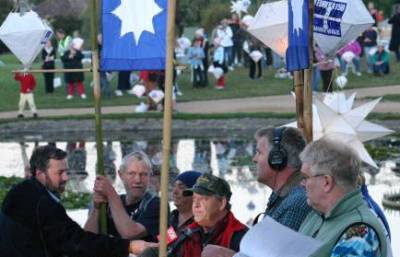
About 1,000 people participated in the Dawn Walk in Ballarat to commemorate the attack on the Eureka Stockade in 1854, and listened to Terry Hicks compare the detention of his son as a suspected terrorist to the injustices faced by the Eureka miners. "One-hundred-and-fifty years ago there was a lot of injustices," he said. "Today, particularly on my side, and what I'm doing, we still have injustices."
While there was a vocal interjection during his talk, there were also people calling out "let him speak".
Organiser of the Dawn Walk, Graeme Dunstan said that each year someone who has been conspicuous and courageous in the defence of our liberties in present times, is honoured as Leading Light. "This year we are grateful to have Terry Hicks, father of Australian Guantanamo Bay prisoner and torture victim, David Hicks, as our Leading Light."
"Terry Hick's tenacious campaign to demand justice for his son is an inspiring Australian story of great love and great courage. In the face of the US tyranny, Terry stands tall and speaks truly for liberty and justice. Eureka spirit! In the name of the father, in the name of the son, he is an inspiration to us all. Father of the century!" said Dunstan.
The walk started out at the mining exchange near the Government Camp after 3.30am. Through stops where an oration of the story is read out, the story of the Eureka Stockade is told. The candles provide a moving atmosphere to meditate on the story of Eureka and what it means.
When the Walkers arrive at the Eureka Memorial at dawn they listen to the Leading Light, in this case Terry Hicks deliver a short speech "to bring the Eureka story to here and now relevance." Afterwards, breakfast is provided to all.
Several prominent people including Premier Jeff Bracks (Baton Charge Bracks) and Alexander Downer condemned the choice of Terry Hicks. Jeff Bracks went on to show his ignorance of the event by criticising it for following the march route of the soldiers when they launched their pre dawn attack in 1854. While some descendents of the Eureka miners were critical of the appointment of Terry Hicks, many were supportive of Hicks selection.
The controversy highlights that Eureka has always been a political event, and remains so today. The digger and soldier monuments in the cemetary highlight the early political controversy. And Howard's refusal to admit the Eureka Flag as a flag of national importance is just as ideologically political. The southern cross still stirs people. Symbols can be powerful.
There are those who would like the commemoration of Eureka to be 'non-political', when in reality they mean non-controversial. But to eliminate the controversy means to destroy the motivation of the original rebellion: solidarity in defending our our rights and liberties against injustice.
Source: Melbourne Indymedia
Eureka 2004 - 150th anniversaryJOIN USFriday 3RD DECEMBER 2004
JOIN US - Celebrate the Past by Reclaiming the Present and creating a new future. Join us at Eureka Park /Eureka Hall (cnr Stawell and Eureka Streets, Ballarat) It's time we reclaimed our history. On Sunday December 5 Join the Eureka Dawn Walk |
The high participation cost of the Releasing the SPIRIT of Democracy Conference ($660) at the St Helen's campus of the University of Ballarat 25-27 November has given rise to a series of Alternative Democracy Forums to be held in Ballarat as part of the Eureka Rising Rebel Festival of the Eureka150 commemorations.
The Alternative Democracy Forums will be themed on the fostering of poverty, the suppression of dissent, the destruction of nature and the dangers to liberty of "anything goes" capitalism.
"The 19th century inventors of democracy thought that a vote for all adults would protect the common people from government by liars, war mongers, secret police, jailers, torturers and agents for the greed and piracy of the rich and privileged," said William Brugman, artist director of the Eureka Rising.
"But the recent re-elections of Howard and Bush has clearly demonstrated to many that democracy has become the best government that corporate money can buy."
The Alternative Democracy Forums began with a Direct Democracy Rally on 26 November outside the Cato Conference Centre on the St Helen's campus in parallel with the official, high price Democracy Conference inside.
Dr Joe Toscano of the Melbourne based, Anarchist Media Institute, helped organise the protest. He was also an invited participant at the Releasing the Spirit Conference. Outside the conference Dr Joe Toscano spoke under a gum tree outside the Cato Centre. He called for an apology from the Victoria Police, for the massacre of miners and innocent bystanders at Eureka in 1854.
Grainery Lane Theatre and Bar also hosted a series of open mike Eureka Rising Democracy Forums. Themes included: Democracy in the Age of the Neo Cons on 25 November; and Reinventing Democracy in the 21 Century for Peace, Justice and the Earth on 26 November.
On Saturday 4 December in Eureka Park after the conclusion of the Diggers March, Green Left will be conducting an open mike Industrial Democracy Forum with keynote speaker Jim McIllroy, a Queensland labour organiser and historian.
Also on Saturday, from 4 to 8 pm in Grainery Lane, another Forum will gather around the theme of the "OZ"-US "Free Trade Agreement" and the Erosion of Democracy. Speakers will include activist/publisher, Dr Susan Hawthorne, feminist advocate, Dr Caroline Taylor, and environmental researcher and campaigner, Michelle van Gerrevink.
Further information:
Source: Melbourne Indymedia
The incidents that contributed to the rebellion on Palm Island last week are eerily familiar to the events that unfolded in Ballarat 150 years ago this week.
Both rebellions occurred as a result of governments that had long ceased to listen to the people they ruled. Both rebellions occurred as a result of the extremely poor relationship between the disciplinary arm of the state, the police, and the people they -control, administer and order on behalf of the state. Both rebellions occurred as a result of the death of a member of their community in suspicious circumstances.
The parallels do not end there. Both open displays of defiance have been labelled by the authorities and the fourth estate as riots and a violent disturbance by a crowd of people. Both incidents have been dismissed as open resistance to authority: a rebellion. In both instances, the state acted with overwhelming force.
At Ballarat, the survivors of the Eureka massacre were rounded up and 13 were charged with high treason. The 13 were acquitted by a jury of their peers, and the Victorian Colonial authorities, realising they faced a political crisis that required political answers not policing, met the miners' demands within a year of the rebellion.
In Australia in 2004, federal and state governments and both major political parties have supported increasingly authoritarian solutions to the problems facing indigenous Australians. They have failed to acknowledge the relationship between the current difficult situation in most indigenous communities and the past.
And to add insult to injury, they have abolished ATSIC, an organisation in which indigenous people had the right to elect their own representatives, and replaced it with an advisory body that meets three times a year.
The significance of the Eureka rebellion has been denied for nearly 150 years, dismissed as some insignificant riot about mining licences. It's only as the 150th anniversary of the Eureka massacre approaches that its role in the development of Australian society has been acknowledged.
Let's hope it doesn't take non-indigenous Australians and their governments 150 years to realise the significance of the Palm Island rebellion - a rebellion that, in its own way, has indicated that political problems require political solutions, not outside imposed policing and paternalistic social solutions.
Joseph Toscano, spokesman, Anarchist Media Institute, Parkville
|
|
The American Consul stationed in Melbourne had been able to arrange to have the other Americans that had been arrested at Eureka to be released. No such arrangements were made for Joseph and he found himself facing execution in February 1855. The first of the Treason trials was considered to be such an important trial, that the Attorney General William Stawell represented the Crown and Chief Justice a' Beckett sat on the bench. Two of the barristers that had acted for the prisoners tried for the burning of Bentley's pub, Butler Cole Aspinall and Henry Chapman, volunteered to act for Joseph. The whole of Melbourne eagerly awaited the outcome of the trial.
The first test of the legal process came with the selection of the jury. The Crown challenged the inclusion of Irish jurors, publicans and other questionable persons. Joseph brought the court to a standstill when he called out that he objected to the inclusion of gentlemen and merchants in the jury. It took some time for the laughter in the courtroom to subside and for the jury selection process to continue. No Irishmen found their way into the ranks of the jury, although a number of 'gentlemen' were selected to be on Joseph's jury.
The charge against him stated 'He had made war against our Lady the Queen in order to subvert authority, he had tried to injure her and force her to change her measures and counsels, he had attempted to deprive her of authority in this colony and, finally he had killed and wounded her soldiers and other loyal subjects'. The trial was over in a few days, the jury made up their minds in record time and acquitted John Joseph.
The scenes that occurred next have seldom been witnessed in Melbourne. The courtroom erupted, the cheering at the verdict so affronted Chief Justice a' Beckett , he singled out two members of the audience and jailed them for a week for affronting the dignity of the court. Joseph was placed on a chair and lifted above the crowd, thousands, possibly up to 50,000 people over a quarter of Melbourne's population in 1855 chaired him through the streets of the city.
The Anarchist Media Institute has organised a gathering outside the Supreme Court of Victoria for midday Wednesday the 25th February to give people the opportunity to celebrate the 149th anniversary of this tumultuous week. We encourage our readers to research the history of the countryside, villages, towns and cities they live in and reclaim their radical history. As activists we need to reclaim our history to understand the present and use the lessons of those events to change the future.
John Joseph was just the first acquitted of treason. Twenty people gathered outside the Supreme Court to commemorate the 149th anniversary of the Eureka trial.
Curious barristers and legal workers slowed down to read what the gathering was about, before continuing on their way.
Source: Melbourne Indymedia
http://melbourne.indymedia.org/news/2004/02/63272_comment.php
Contact Takver with questions or comments about this web site.